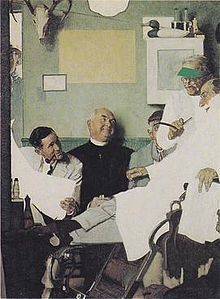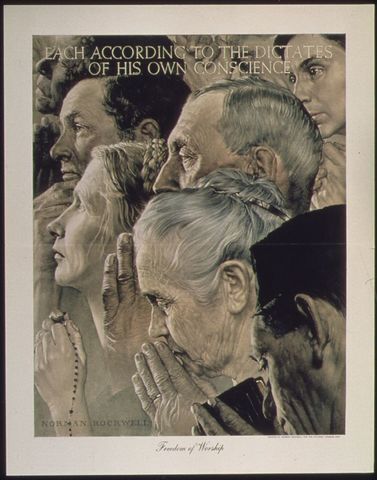As the Second World War was raging across the globe and the U.S. was getting sucked into the conflict, artist Norman Rockwell petitioned The Saturday Evening Post for a commission to paint visual representations of four ideals. These fundamental freedoms were identified by President Franklin D. Roosevelt as basic human rights in a speech he delivered to Congress in 1941. He called them the four freedoms: the freedom of speech, the freedom of worship, the freedom from want, and the freedom from fear.
The magazine granted Rockwell’s request, and the resulting four paintings were finished and printed in 1943.
The paintings were massively successful and were widely requested for reprint by the Post's audience. Additionally, they were used, among others, as part of a war bond campaign, which raised $133 million dollars for the war effort, according to nrm.org.
Coming up with an image that represented the freedom of worship proved to be a challenge for the artist, and the painting’s layout underwent several changes before the design was finalized. The finished painting depicts people of different cultures, races and religions worshipping in their own chosen way.

The original draft of Freedom of Worship was set in a barber shop.

The final version of Freedom of Worship.
Inscribed at the top of the final painting are the words: “Each according to the dictates of his own conscience.”
For members of The Church of Jesus Christ of Latter-day Saints, the words are easily recognizable as a slightly altered section of the 11th Article of Faith written by Joseph Smith in 1842: “We claim the privilege of worshiping Almighty God according to the dictates of our own conscience, and allow all men the same privilege, let them worship how, where, or what they may.”
The phrase rose into prominence in the world’s eye because of Rockwell’s painting.
Curiously, Rockwell could not remember where he first saw the phrase, writing, "I know I read it somewhere but no one has been able to find it in any book or document.” However, historians believe it was probably from Smith’s writingswhich were a century old but still in print, according to Smithsonian.com and Brattleboro Reformer.
Additionally, author Laura Claridge, in her book Norman Rockwell: A Life, wrote, "Across the top of the canvas the aphorism 'Each according to the dictates of his own conscience' is lettered in gold, a platitude that suggests the plurality of Rockwell's own thoughts on religion: its likely source was a phrase included in the 'Thirteen Articles of Faith' by Joseph Smith, the founder of the Church of Jesus Christ of Latter-day Saints" (312).
However, it's important to note that similar wording was used in other government documents during that time period.
From the Utah pioneers to more recent humanitarian efforts done by the Church, Latter-day Saints have left indelible marks across U.S. history, and Joseph Smith's influence on one of Norman Rockwell's greatest paintings is yet another way which Church members have helped shape U.S. society.
Images from Wikipedia

